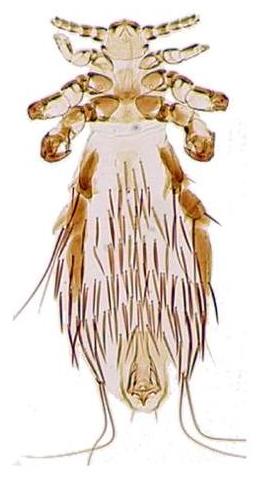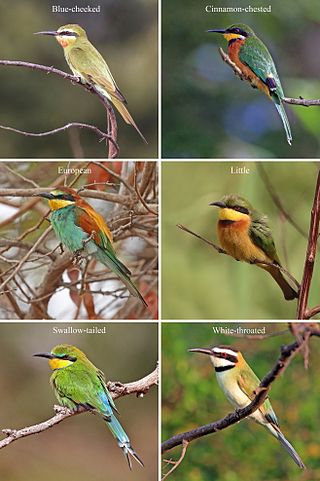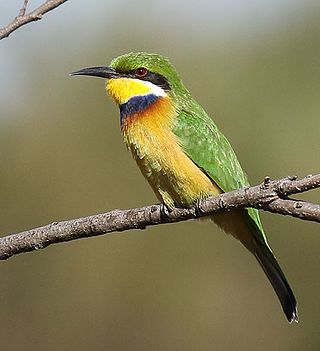
Louse is the common name for any member of the clade Phthiraptera, which contains nearly 5,000 species of wingless parasitic insects. Phthiraptera has variously been recognized as an order, infraorder, or a parvorder, as a result of developments in phylogenetic research.

The genus Haematomyzus includes three species of lice that differ so markedly from all other lice that the genus is placed in its own family Haematomyzidae, itself monotypic within the superfamily Rhynchophthirina. These unusual lice are ectoparasites of elephants and warthogs. Their mouthparts are elongated to form a drill-like structure that allows them to penetrate the thick skin of their host.

The bee-eaters are a group of birds in the family Meropidae, containing three genera and thirty-one species. Most species are found in Africa and Asia, with a few in southern Europe, Australia, and New Guinea. They are characterised by richly coloured plumage, slender bodies, and usually elongated central tail feathers. All have long down-turned bills and medium to long wings, which may be pointed or round. Male and female plumages are usually similar.

The European bee-eater is a near passerine bird in the bee-eater family, Meropidae. It breeds in southern and central Europe, northern and southern Africa, and western Asia. Except for the resident southern African population, the species is strongly migratory, wintering in tropical Africa. This species occurs as a spring overshoot north of its usual range, with occasional breeding in northern Europe.

The blue-cheeked bee-eater is a near passerine bird in the bee-eater family, Meropidae. The genus name Merops is Ancient Greek for "bee-eater", and persicus is Latin for "Persian".

The blue-tailed bee-eater is a near passerine bird in the bee-eater family Meropidae. It is widely distributed across South and Southeast Asia where many populations are strongly migratory, and seen seasonally in many parts but breeding colonially in small areas across their range, mostly in river valleys, where they nest by tunneling into loamy sand banks. They are seen mostly in open habitats close to water.

The little bee-eater is a bird species in the bee-eater family, Meropidae. They are found in Sub-Saharan Africa. They should not be confused with the little green bee-eater. Migration is limited to seasonal movements depending on rainfall patterns.

The Asian green bee-eater, also known as little green bee-eater, and green bee-eater in Sri Lanka, is a near passerine bird in the bee-eater family. It is resident but prone to seasonal movements and is found widely distributed across Asia from coastal southern Iran east through the Indian subcontinent to Vietnam. Populations in Africa and the Arabian Peninsula that were formerly assigned to this species are now considered distinct species: the African green bee-eater and the Arabian green bee-eater. They are mainly insect eaters and they are found in grassland, thin scrub and forest often quite far from water. Several regional plumage variations are known and several subspecies have been named.

The swallow-tailed bee-eater is a near passerine bird in the bee-eater family, Meropidae.

The olive bee-eater or Madagascar bee-eater is a near passerine bee-eater species in the genus Merops. It is native to the southern half of Africa where it is present in Angola; Botswana; Burundi; Comoros; Democratic Republic of the Congo; Djibouti; Eritrea; Ethiopia; Kenya; Madagascar; Malawi; Mayotte; Mozambique; Namibia; Rwanda; Somalia; South Sudan; Sudan; Tanzania; Uganda; Zambia; Zimbabwe. It is a common species with a wide range so the International Union for Conservation of Nature has rated their conservation status as "least concern".

Psocoptera are a paraphyletic group of insects that are commonly known as booklice, barklice or barkflies. The name Psocoptera has been replaced with Psocodea in recent literature, with the inclusion of the former order Phthiraptera into Psocodea.

The rainbow bee-eater is a near passerine bird in the bee-eater family Meropidae.

Menoponidae is a monophyletic family of lice in the superfamily of chewing lice, Amblycera, often referred to as the chicken body louse family. They are ectoparasites of a wide range of birds including chickens, which makes them important to understand for veterinary science and for human health. However, Menoponidae are not exclusive to poultry and are common parasites for migratory birds, with more and more species being discovered every year.

The blue-breasted bee-eater is a central African species of bird. It is a member of the family Meropidae. Meropids are all visually similar and have a diet specialized in Hymenopterans.

The blue-throated bee-eater is a species of bird in the bee-eater family. They are found throughout southeast Asia in subtropical or tropical mangrove forests. Their diet consists mostly of bees, wasps, and dragonflies. Blue-throated bee-eaters are small with colorful plumage consisting of a red nape, dark green wings, light green breast, and their signature blue throat. Juvenile plumage contain dark green head and wings and light green breasts, only developing their full plumage in adulthood. They have a rich variety of songs and calls, including longcalls which allow them to communicate long distances in the forest.
The Laemobothriidae are a family of a larger group Amblycera of the chewing lice. Most commonly they are ectoparasites of birds. The genera are sometimes all united in Laemobothrion.
Brueelia is a genus of bird lice in the family Philopteridae that infest Passerine (perching) birds. Lice in Brueelia are usually host specific, with more than 85% of described species each found on a single host bird species. Over 300 species of Brueelia have been described, and many more specimens that are presumed to belong to Brueelia are awaiting description and naming.

The Ricinidae are a family of a larger group Amblycera of the chewing lice. All species are relatively large bodied avian ectoparasites. They typically exhibit low prevalence and low intensity. They feed on host blood which is atypical in chewing lice. Two or three genera are recognized.

Colpocephalum is a genus of chewing louse. Christian Ludwig Nitzsch named the genus in 1818. The Plenary Powers of the International Commission on Zoological Nomenclature selected Colpocephalum zebraBurmeister, 1838 as its type species in the 1950s. There are approximately 135 species in this genus, and they are ectoparasites of birds in at least a dozen different orders.

The Manol is a river in Alt Empordà, Catalonia, Spain. It is a seasonal river, and a tributary of the Muga. An emblematic bird of the river is the European bee-eater, a migratory bird that overwinters in tropical Africa.

















